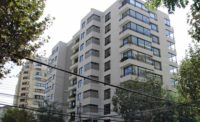Renewed earthquake paranoia has hit Los Angeles since an Oct. 12 report in the Los Angeles Times labeled more than 1,000 buildings as "at risk" for collapse in a quake. In response, Los Angeles Mayor Eric Garcetti (D) promised to appoint a quake "czar" to determine if retrofits of the city's older reinforced-concrete structures are needed.
The Times' list—compiled through building-permit research and an owner survey—includes mostly reinforced-concrete buildings engineered between the 1960s and the mid-1980s. "This class of building exists in every major city," says Ronald Hamburger, head of structural engineering for Simpson Gumpertz & Heger Inc.
The 1994 magnitude-6.7 Northridge quake raised the same issues, says Thomas Heaton, a seismologist at the California Institute of Technology, Pasadena. But attention waned because, when the quake hit at 4 a.m., people weren't in the concrete office buildings that collapsed.
In Northridge's wake, then-mayor Tom Bradley put together a task force to test concrete structures, but it did not get very far, adds Heaton.
Before the 1980s, engineers didn't fully understand the importance of tying loops to cage the reinforcing steel in concrete structures. "This was shown with the destruction in Mexico City in [its 1985 quake]," he says. "Ironically, buildings built with masonry or wood are far more resilient than these engineered buildings from the 1960s and early 1970s."
Most of the concrete buildings built prior to the 1960s had their fair share of solid walls, which are safer than column-only structures. "They might not be built to present-day code, but [they] do provide seismic resistance," says Hamburger.
The fact that older concrete structures are at risk is well recognized because of the 1971 Sylmar quake, Heaton adds. "But many of these occupants don't know they're in fragile buildings that haven't been tested," he says.
Hamburger says seismic retrofits could cost nearly $100 per sq ft, not counting the expense of relocating tenants.



Post a comment to this article
Report Abusive Comment